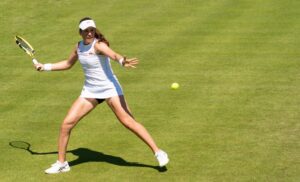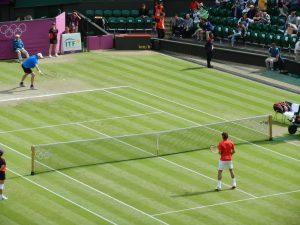We may earn money or products from the companies mentioned in this post.
Introduction

Tennis, a sport loved by millions around the world, has a rich history and continues to gain popularity with each passing year From its humble beginnings to the modern game we know today, tennis has evolved into a thrilling and competitive sport that captivates both players and spectators alike
Origins and Early Development
Tennis can trace its roots back to ancient civilizations such as Egypt, Greece, and Rome The earliest form of the game was played with bare hands or rudimentary tools, hitting a ball against a wall or over a makeshift net Over time, variations of the game emerged in different cultures across the globe
In the 19th century, tennis gained significant recognition in England when Major Walter Clopton Wingfield invented an early version of lawn tennis This marked the beginning of organized competitions and standardized rules for the game Tennis quickly spread throughout Europe and beyond, captivating players from all walks of life
The Evolution of the Modern Game
The modern game of tennis took shape in the late 19th and early 20th centuries The introduction of rackets made from wood or metal allowed for more power and control in shots Tournaments like Wimbledon, established in 1877, became prestigious events that attracted top players from around the world
With advances in technology, tennis experienced further transformations The introduction of synthetic materials for rackets led to increased power and spin on shots Additionally, improvements in court surfaces provided different playing conditions that affected gameplay strategies
Importance of Sound in Sports: Specifically Tennis
Sound plays an integral role in sports performance, particularly in games like tennis where split-second decisions can make all the difference between victory and defeat Auditory cues provide crucial information to players during a match, helping them react and adjust their strategies accordingly
The Role of Auditory Cues in a Player’s Performance
When playing tennis, players rely on the sound of the ball hitting the racket to gauge the timing and quality of their shots The distinct thud or crack of a well-struck ball can provide valuable feedback on shot accuracy and power This auditory feedback allows players to make adjustments and refine their technique as they strive for optimal performance
Furthermore, sound can also aid players in anticipating their opponent’s moves By listening to the sound of an incoming shot, skilled players can gain insights into the type of shot being played – whether it’s a powerful serve or a delicate drop shot This information helps them prepare and position themselves effectively on the court
Different Types of Sounds Made by Athletes During Competition
In tennis, various sounds are produced by athletes during competition, each carrying its own significance The crisp “thwack” when the ball is struck cleanly by the racket indicates a well-executed shot with proper technique On the other hand, a mishit or mis-timed shot may result in an awkward “clunk” or “squeak,” revealing flaws in execution that need correction
Apart from ball-to-racket contact sounds, other auditory cues include player grunts and shouts Although controversial at times, these vocalizations have been shown to help players generate additional power and focus during intense rallies They also add an emotional element to matches, enhancing spectator engagement
Reasons behind moaning in tennis

In the intense and competitive world of tennis, players often find themselves unleashing audible sounds during matches While some may see it as unnecessary or distracting, there are several reasons why players resort to moaning on the court Understanding these reasons can shed light on this controversial aspect of the game
Physical exertion and energy release
1 Explaining the link between grunting and physical effort
Grunting in tennis is commonly associated with the physical exertion required to hit powerful shots The sound produced during a player’s stroke can be an involuntary result of the sheer force they put into their swings
a How grunting may help conserve energy
Believe it or not, grunting can actually help players conserve energy during long matches By exhaling forcefully while hitting the ball, players engage their core muscles, stabilizing their body and generating extra power without excessive strain
b Psychological benefits for the player
Additionally, emitting vocal sounds can have psychological benefits for players by providing a sense of focus and enhancing their overall performance on the court It helps them channel their energy and stay mentally engaged throughout challenging rallies
Intimidation and psychological warfare tactics
1 Impact on opponents’ concentration and reaction time
The moans and groans emitted by some players have been known to disrupt their opponents’ concentration and hinder their reaction time The sudden loud noises can catch opponents off guard, leading to mistimed shots or diminished decision-making abilities
a Studies showing how loud noises can disrupt focus
Studies have shown that unexpected loud noises can significantly impact concentration levels, especially in sports like tennis where split-second decisions are crucial The grunts and groans can create a distraction that affects opponents’ ability to maintain their focus during rallies
b Examples from professional matches where players were affected by an opponent’s moaning
There have been numerous instances in professional matches where players have openly admitted to being affected by their opponent’s moaning The unexpected and loud sounds can disrupt rhythm, break concentration, and even lead to frustration or annoyance on the receiving end
Communication with self or coach during play
1 Examples from professional matches where players use sounds to communicate their thoughts
While it may seem unusual, some players use vocalizations as a means of communication with themselves or their coaches during intense moments on the court These sounds serve as a way to reinforce strategies, remind themselves of key tactics, or simply release built-up tension
In conclusion, there are various reasons why tennis players resort to moaning during matches From physical exertion and energy release to intimidation tactics and even internal communication, these audible expressions serve different purposes for different players Understanding the motivations behind these sounds can provide valuable insights into the psychology and dynamics of tennis at the highest level
Analysis: Is moaning really necessary?

There has long been a spirited debate among professionals, coaches, and fans about the necessity of loud noises on the tennis court Some argue that vocalizations play an integral role in the game, while others believe they are unnecessary distractions Let’s explore both sides of this contentious issue
Arguments for allowing vocalizations in tennis
The cultural aspect:
Tennis is a global sport with players from diverse backgrounds and training styles Different cultures may have unique playing styles that incorporate vocalizations as a natural part of their game By allowing players to express themselves through vocal cues, we celebrate and respect these cultural nuances
The freedom to express:
Tennis can be an incredibly high-stress sport, with intense rallies and crucial moments that put athletes under immense pressure Allowing players to release their emotions through moans or grunts can provide them with a sense of relief and help them manage their stress levels on the court
Arguments against excessive moaning
Potential negative impact on opponents’ performance:
Excessive moaning or grunting during matches can have a detrimental effect on opponents’ concentration and focus The sudden bursts of noise can disrupt their rhythm and timing, making it harder for them to execute their shots effectively
Disruptive effect on overall match atmosphere:
Tennis is not just a battle between two individuals; it is also an immersive experience for spectators Excessive vocalizations can create an unpleasant atmosphere for both viewers at home and those attending live matches It may detract from the beauty of the game itself and overshadow other aspects such as strategy and skill
By considering these differing perspectives, we can gain a deeper understanding of the ongoing debate surrounding the necessity of moaning in tennis It is a complex issue that requires careful consideration of cultural significance, player expression, and the overall impact on the game
Regulation and Potential Solutions

In the world of sports, noise levels during matches can sometimes become a contentious issue Whether it’s the crowd cheering or players expressing themselves on the court, striking a balance between excitement and disruption is crucial To address this challenge, current regulations exist regarding noise levels during matches
Current Rules Regarding Noise Levels During Matches
1 Existing guidelines for acceptable behavior on court:
Players are expected to conduct themselves in a manner that demonstrates respect for their opponents and the game itself While some level of vocalization is considered normal and even encouraged in certain situations, excessive noise can be disruptive to both players and spectators
2 Enforcement challenges faced by officials:
Ensuring compliance with these guidelines can be challenging for officials The subjective nature of what constitutes excessive noise makes it difficult to enforce consistently across different matches and players
Proposed Changes to Address Excessive Moaning
To tackle the issue of excessive moaning during matches, several potential solutions have been proposed:
-
Suggestions for possible rule modifications:
One approach could be to introduce specific noise limits for players By setting clear boundaries, players would have a better understanding of what is deemed acceptable vocalization and what crosses the line into disruptive territory -
Educational and training solutions:
Another avenue to explore is education and training initiatives aimed at addressing excessive moaning This could involve encouraging coaches to teach proper breathing techniques that can help reduce unnecessary vocalizations during intense moments on the court -
Promoting sportsmanship and respect between players:
Fostering an environment of good sportsmanship and respect is also crucial in addressing excessive moaning By promoting these values, players may be more inclined to show restraint and refrain from excessive vocalizations that can distract their opponents
Implementing a combination of these proposed changes could contribute to resolving the issue of excessive moaning during matches Striking a balance between allowing players to express themselves and maintaining an atmosphere conducive to fair play is key in ensuring an enjoyable sporting experience for all
Useful Links

Why do some female tennis players moan or grunt when …
Why do tennis players grunt, and which …
What can science tell us about grunting in tennis?
7 Reasons Why Tennis Players Grunt – Moaning In Tennis
Grunting in Tennis: A History of Screaming on the Court
Why do tennis players grunt?
Why tennis players grunt, and why you should, too!
Grunting in tennis – a problem that won’t go away
Why Do Tennis Players Grunt?
Why Do Table Tennis Players Grunt? (Explained) – PingPongIt
Grunting and tennis: Why the case to ban women …
Why Tennis players grunt so loudly during matches – HITC
Maria Sharapova and the Worst Grunts in Tennis Today
Women’s tennis battles ‘grunt work’
Why do professional players moan when hitting the ball?
Most Pornographic Grunts in Men’s Tennis
In Defense of the Tennis Grunt: Why a Bold Exhale Could …
To Boost Sports Performance (and Annoy Your Opponents) …






